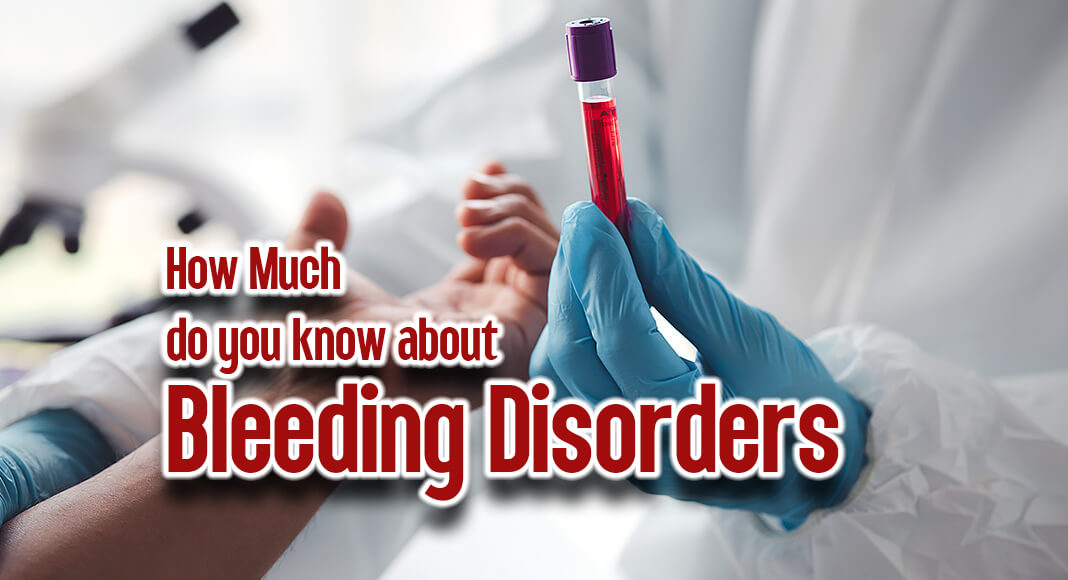
Mega Doctor News
What Is A Bleeding Disorder?
Bleeding disorders are conditions in which the blood does not clot normally because certain proteins in the blood are missing or do not work properly.
Von Willebrand Disease
Von Willebrand disease (VWD) is an inherited bleeding disorder in which the blood does not clot properly. Blood contains many proteins that help the blood clot when needed. One of these proteins is called von Willebrand factor (VWF). People with VWD either have a low level of VWF in their blood or the VWF protein doesn’t work the way it should. There are three types of VWD: type 1 (the most common and mildest form of VWD), type 2, and type 3 (the most severe form of VWD).
The signs and symptoms of VWD include:
- Frequent or hard-to-stop nosebleeds.
- Easy bruising.
- Longer-than-normal bleeding after injury, surgery, and dental work.
- Women with VWD can experience heavy or abnormal bleeding during menstrual periods and after childbirth.
Hemophilia
Hemophilia is an inherited bleeding disorder in which the blood does not clot properly due to a lack or decrease in a protein called clotting factor. The two most common types of hemophilia are hemophilia A, which is due to a lack of clotting factor VIII (8) and hemophilia B, which is due to a lack of clotting factor IX (9).
The signs and symptoms of hemophilia include:
- Frequent or hard-to-stop nosebleeds.
- Easy bruising.
- Longer-than-normal bleeding after injury, surgery, and dental work.
- Bleeding into the joints. This can cause swelling and pain or tightness in the joints; it often affects the knees, elbows, and ankles.
- Bleeding into the skin (which is bruising) or muscle and soft tissue causing a build-up of blood in the area (called a hematoma).
Who Is Affected by Bleeding Disorders?
VWD is the most common bleeding disorder, found in up to 1% of the U.S. population. This means that 3.2 million (or about 1 in every 100) people in the United States have the disease. Although VWD occurs among men and women equally, women are more likely to notice the symptoms because of heavy or abnormal bleeding during their menstrual periods and after childbirth.
The exact number of people with hemophilia is unknown.
he majority of hemophilia and VWD cases are inherited and there is a known family history of the disorder. However, about one-third of familieswith babies who are diagnosed with hemophilia report having no known history of the disorder. Both hemophilia and VWD can also be caused by a spontaneous (random) change in a mother or child’s gene.
Read personal stories from people who have VWD and hemophilia to learn more about their experiences. Living with the complications of a bleeding disorder can be challenging; however, with treatment, people with bleeding disorders can manage their bleeding symptoms.
What is CDC Doing to Help People with Bleeding Disorders?
Community Counts
Community Counts is a public health monitoring program funded by CDC’s Division of Blood Disorders and Public Health Genomics. The goal of Community Counts is to monitor the health of people living with hemophilia and other bleeding disorders who are receiving care at more than 140 U.S. Hemophilia Treatment Centers (HTCs).
The Community Counts program gathers and shares information from HTCs about the characteristics of people with bleeding disorders, and their treatments, bleeding symptoms, and long-term medical complications.
Data from Community Counts has informed public health and clinical guidelines and practices to prevent or reduce hemophilia-related health problems. Read a summary report on the Community Counts program, or read the full report here.
If you or someone you know has a bleeding disorder, learn more about Community Counts eligibility and participation here.
Better You Know
The Better You Know campaign, developed by the National Bleeding Disorders Foundation in partnership with the CDC, raises awareness of bleeding disorders among women and girls who may experience symptoms but have not yet been diagnosed.As many as 1% of women in the United States may have a bleeding disorder, and many do not know it. The Better You Know campaign was created to help you find out if you might be at risk for a bleeding disorder.
Women and girls can take a free, web-based risk assessment to learn whether they may be at risk for a bleeding disorder on the Better You Know webpage. If they are at risk, free tools and resources are available in English and Spanish to help them take steps towards seeking care. These resources will help women and girls receive testing as well as an accurate diagnosis and treatment plan, if needed, from their healthcare providers.
Better You Know also has resources for healthcare providers and educators to increase their knowledge and awareness of bleeding disorders in women.
Visit CDC’s webpage to learn more about bleeding disorders in women and girls and how you can take steps to protect your health.
Information Source: CDC










